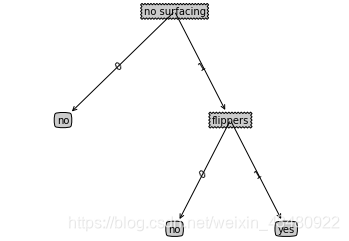PS1: 以下代码使用py3.7执行,原书出版于2013年(大概是),示例代码都是10年和11年写的, 使用的是py2的语法, 有许多不能执行,如:
- dict_keys.keys()[*]
- dict.iteritems()
- 等
PS2:所有代码均在Jupyter Notebook上测试, 所需包及版本如下
- numpy :1.16.5
- matplotlib :3.1.1
3 决策树
计算给定数据集的香农熵
from math import log
def calcShannonEnt(dataSet):
numEntrys = len(dataSet)
labelCounts = {}
for featVec in dataSet:
currentLabel = featVec[-1]
if currentLabel not in labelCounts.keys():
labelCounts[currentLabel] = 0
labelCounts[currentLabel] += 1
shannonEnt = 0.0
for key in labelCounts:
prob = float(labelCounts[key])/numEntrys
shannonEnt -= log(prob, 2)*prob
return shannonEnt
dataSet = [[1,1,'yes'],[1,0,'yes'],[1,0,'no'],[0,1,'no'],[0,1,'no']]
calcShannonEnt(dataSet)
0.9709505944546686
按照给定的特征划分数据集
def splitDataSet(dataSet, axis, value):
retDataSet = []
for featVec in dataSet:
if featVec[axis] == value:
reduceFeatVec = featVec[:axis]
reduceFeatVec.extend(featVec[axis+1:])
retDataSet.append(reduceFeatVec)
return retDataSet
splitDataSet(dataSet, 0, 0)
[[1, 'no'], [1, 'no']]
选择最好的数据集划分方式
def chooseBestFeatureToSplit(dataSet):
numFeatures = len(dataSet[0]) - 1 # 最后一位是标签
baseEntropy = calcShannonEnt(dataSet)
bestInfoGain = 0.0; bestFeature = -1
for i in range(numFeatures): #迭代所有特征
print("The",str(i)+'th',"feature:")
featList = [example[i] for example in dataSet]
uniqueVals = set(featList)
newEntropy = 0.0
for value in uniqueVals:
subDataSet = splitDataSet(dataSet, i, value)
prob = len(subDataSet)/float(len(dataSet))
newEntropy += prob * calcShannonEnt(subDataSet)
print(newEntropy)
infoGain = baseEntropy - newEntropy
if (infoGain > bestInfoGain):
bestInfoGain = infoGain
bestFeature = i
return bestFeature
chooseBestFeatureToSplit(dataSet)
The 0th feature:
0.5509775004326937
The 1th feature:
0.9509775004326937
0
set() 函数创建一个无序不重复元素集,可进行关系测试,删除重复数据,还可以计算交集、差集、并集等。
多数表决函数
该函数返回出现次数最多的分类名称
import operator
def majorityCnt(classList):
classCount={}
for vote in classList:
if vote not in classCount.keys():
classCount[vote] = 0
classCount[vote] += 1
sortedClassCount = sorted(classCount.items(), key=operator.itemgetter(1), reverse=True)
return sortedClassCount[0][0]
创建树函数
def createTree(dataSet,labels):
classList = [example[-1] for example in dataSet]
# 当所有分类都相同的话就停止继续划分
if classList.count(classList[0]) == len(classList):
return classList[0]
# 当没有特征的时候停止划分,因为没什么能够划分的了
# dataSet[0]只是取第一个数据的特征,与后面数据的特征数相同
if len(dataSet[0]) == 1:
return majorityCnt(classList)
# 以上条件都不满足的情况下继续划分
# 找到最佳划分的特征
bestFeat = chooseBestFeatureToSplit(dataSet)
bestFeatLabel = labels[bestFeat]
myTree = {bestFeatLabel:{}}
# 删除分类
del(labels[bestFeat])
featValues = [example[bestFeat] for example in dataSet]
# 得到剩余的特征
uniqueVals = set(featValues)
for value in uniqueVals:
subLabels = labels[:]
myTree[bestFeatLabel][value] = createTree(
splitDataSet(dataSet, bestFeat, value),subLabels)
return myTree
dataSet = [[1,1,'yes'],[1,0,'yes'],[1,0,'no'],[0,1,'no'],[0,1,'no']]
labels = ['no surfacing','flippers' ]
labels.index('no surfacing')
0
myTree = createTree(dataSet, labels)
The 0th feature:
0.5509775004326937
The 1th feature:
0.9509775004326937
The 0th feature:
0.6666666666666666
myTree
{'no surfacing': {0: 'no', 1: {'flippers': {0: 'yes', 1: 'yes'}}}}
测试函数
def classify(inputTree,featLabels,testVec):
# print(list(inputTree.keys())[0])
firstStr = list(inputTree.keys())[0]
# print(firstStr)
secondDict = inputTree[firstStr]
featIndex = featLabels.index(firstStr)
key = testVec[featIndex]
valueOfFeat = secondDict[key]
if isinstance(valueOfFeat, dict):
classLabel = classify(valueOfFeat, featLabels, testVec)
else: classLabel = valueOfFeat
return classLabel
classify(myTree, labels, [0,0] )
---------------------------------------------------------------------------
NameError Traceback (most recent call last)
<ipython-input-2-b04367226231> in <module>
----> 1 classify(myTree, labels, [0,0] )
NameError: name 'myTree' is not defined
存储树
def storeTree(inputTree,filename):
import pickle
fw = open(filename,'wb')
pickle.dump(inputTree,fw)
fw.close()
storeTree(myTree,'myTree')
myTree
{'no surfacing': {0: 'no', 1: {'flippers': {0: 'yes', 1: 'yes'}}}}
加载树
def grabTree(filename):
import pickle
fr = open(filename,'rb+')
return pickle.load(fr)
grabTree('myTree')
{'no surfacing': {0: 'no', 1: {'flippers': {0: 'yes', 1: 'yes'}}}}
3.2 使用Matplotlib注解绘制树形图
Matplotlib提供了一个非常有用的注解工具annotations, 它可以在数据图形上添加文本注解
3.2.1 Matplotlib注解
import matplotlib.pyplot as plt
# 定义决策树决策结果的属性,用字典来定义
# 下面的字典定义也可写作 decisionNode={boxstyle:'sawtooth',fc:'0.8'}
# boxstyle为文本框的类型,sawtooth是锯齿形,fc是边框线粗细
decisionNode = dict(boxstyle="sawtooth", fc="0.8")
leafNode = dict(boxstyle="round4", fc="0.8")
arrow_args = dict(arrowstyle="<-")
<matplotlib.axes._subplots.AxesSubplot at 0x1af02b8feb8>
def plotNode(nodeTxt, centerPt, parentPt, nodeType):
createPlot.ax1.annotate(nodeTxt, xy=parentPt, xycoords='axes fraction',
xytext=centerPt, textcoords='axes fraction',
va="center", ha="center", bbox=nodeType, arrowprops=arrow_args )
得到树的叶子数和深度
def getNumLeafs(myTree):
numLeafs = 0
firstStr = list(myTree.keys())[0]
secondDict = myTree[firstStr]
for key in secondDict.keys():
if type(secondDict[key]).__name__=='dict':#test to see if the nodes are dictonaires, if not they are leaf nodes
numLeafs += getNumLeafs(secondDict[key])
else: numLeafs +=1
return numLeafs
def getTreeDepth(myTree):
maxDepth = 0
firstStr = list(myTree.keys())[0]
secondDict = myTree[firstStr]
for key in secondDict.keys():
if type(secondDict[key]).__name__=='dict':#test to see if the nodes are dictonaires, if not they are leaf nodes
thisDepth = 1 + getTreeDepth(secondDict[key])
else: thisDepth = 1
if thisDepth > maxDepth: maxDepth = thisDepth
return maxDepth
# 预先存储树的信息,避免每次测试代码都要从数据中创建树的麻烦
#
def retrieveTree(i):
listOfTrees =[{'no surfacing': {0: 'no', 1: {'flippers': {0: 'no', 1: 'yes'}}}},
{'no surfacing': {0: 'no', 1: {'flippers': {0: {'head': {0: 'no', 1: 'yes'}}, 1: 'no'}}}}
]
return listOfTrees[i]
getNumLeafs(retrieveTree(0))
3
def plotMidText(cntrPt, parentPt, txtString):
xMid = (parentPt[0]-cntrPt[0])/2.0 + cntrPt[0]
yMid = (parentPt[1]-cntrPt[1])/2.0 + cntrPt[1]
createPlot.ax1.text(xMid, yMid, txtString, va="center", ha="center", rotation=30)
def plotTree(myTree, parentPt, nodeTxt):#if the first key tells you what feat was split on
numLeafs = getNumLeafs(myTree) #this determines the x width of this tree
depth = getTreeDepth(myTree)
firstStr = list(myTree.keys())[0] #the text label for this node should be this
cntrPt = (plotTree.xOff + (1.0 + float(numLeafs))/2.0/plotTree.totalW, plotTree.yOff)
plotMidText(cntrPt, parentPt, nodeTxt)
plotNode(firstStr, cntrPt, parentPt, decisionNode)
secondDict = myTree[firstStr]
plotTree.yOff = plotTree.yOff - 1.0/plotTree.totalD
for key in secondDict.keys():
if type(secondDict[key]).__name__=='dict':#test to see if the nodes are dictonaires, if not they are leaf nodes
plotTree(secondDict[key],cntrPt,str(key)) #recursion
else: #it's a leaf node print the leaf node
plotTree.xOff = plotTree.xOff + 1.0/plotTree.totalW
plotNode(secondDict[key], (plotTree.xOff, plotTree.yOff), cntrPt, leafNode)
plotMidText((plotTree.xOff, plotTree.yOff), cntrPt, str(key))
plotTree.yOff = plotTree.yOff + 1.0/plotTree.totalD
def createPlot(inTree):
fig = plt.figure(1, facecolor='white')
fig.clf()
axprops = dict(xticks=[], yticks=[])
createPlot.ax1 = plt.subplot(111, frameon=False, **axprops) #no ticks
#createPlot.ax1 = plt.subplot(111, frameon=False) #ticks for demo puropses
plotTree.totalW = float(getNumLeafs(inTree))
plotTree.totalD = float(getTreeDepth(inTree))
plotTree.xOff = -0.5/plotTree.totalW; plotTree.yOff = 1.0;
plotTree(inTree, (0.5,1.0), '')
plt.show()
createPlot(myTree)

























 653
653











 被折叠的 条评论
为什么被折叠?
被折叠的 条评论
为什么被折叠?








